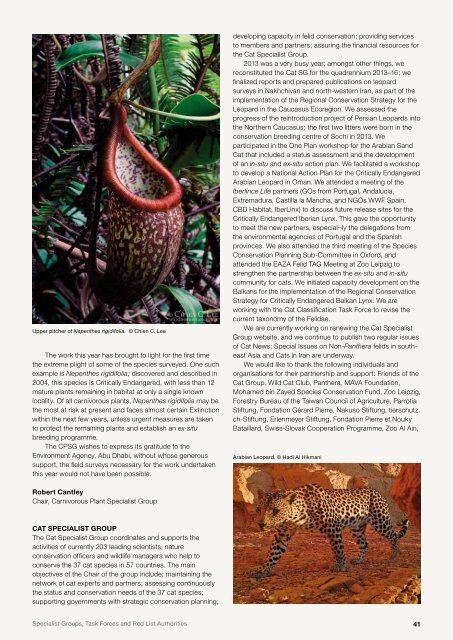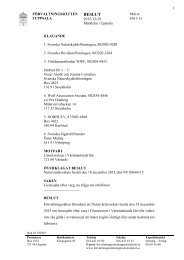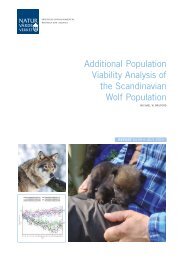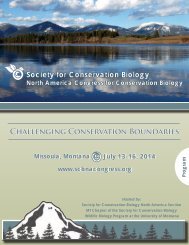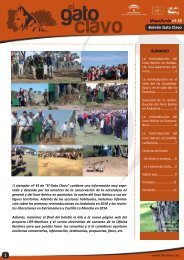1oC3Dbk
1oC3Dbk
1oC3Dbk
You also want an ePaper? Increase the reach of your titles
YUMPU automatically turns print PDFs into web optimized ePapers that Google loves.
Upper pitcher of Nepenthes rigidifolia. © Chíen C. Lee<br />
The work this year has brought to light for the first time<br />
the extreme plight of some of the species surveyed. One such<br />
example is Nepenthes rigidifolia; discovered and described in<br />
2004, this species is Critically Endangered, with less than 12<br />
mature plants remaining in habitat at only a single known<br />
locality. Of all carnivorous plants, Nepenthes rigidifolia may be<br />
the most at risk at present and faces almost certain Extinction<br />
within the next few years, unless urgent measures are taken<br />
to protect the remaining plants and establish an ex-situ<br />
breeding programme.<br />
The CPSG wishes to express its gratitude to the<br />
Environment Agency, Abu Dhabi, without whose generous<br />
support, the field surveys necessary for the work undertaken<br />
this year would not have been possible.<br />
developing capacity in felid conservation; providing services<br />
to members and partners; assuring the financial resources for<br />
the Cat Specialist Group.<br />
2013 was a very busy year; amongst other things, we<br />
reconstituted the Cat SG for the quadrennium 2013–16; we<br />
finalized reports and prepared publications on leopard<br />
surveys in Nakhchivan and north-western Iran, as part of the<br />
implementation of the Regional Conservation Strategy for the<br />
Leopard in the Caucasus Ecoregion. We assessed the<br />
progress of the reintroduction project of Persian Leopards into<br />
the Northern Caucasus; the first two litters were born in the<br />
conservation breeding centre of Sochi in 2013. We<br />
participated in the One Plan workshop for the Arabian Sand<br />
Cat that included a status assessment and the development<br />
of an in-situ and ex-situ action plan. We facilitated a workshop<br />
to develop a National Action Plan for the Critically Endangered<br />
Arabian Leopard in Oman. We attended a meeting of the<br />
Iberlince Life partners (GOs from Portugal, Andalucia,<br />
Extremadura, Castilla la Mancha, and NGOs WWF Spain,<br />
CBD Habitat, IberLinx) to discuss future release sites for the<br />
Critically Endangered Iberian Lynx. This gave the opportunity<br />
to meet the new partners, especial¬ly the delegations from<br />
the environmental agencies of Portugal and the Spanish<br />
provinces. We also attended the third meeting of the Species<br />
Conservation Planning Sub-Committee in Oxford, and<br />
attended the EAZA Felid TAG Meeting at Zoo Leipzig to<br />
strengthen the partnership between the ex-situ and in-situ<br />
community for cats. We initiated capacity development on the<br />
Balkans for the implementation of the Regional Conservation<br />
Strategy for Critically Endangered Balkan Lynx. We are<br />
working with the Cat Classification Task Force to revise the<br />
current taxonomy of the Felidae.<br />
We are currently working on renewing the Cat Specialist<br />
Group website, and we continue to publish two regular issues<br />
of Cat News; Special Issues on Non-Panthera felids in southeast<br />
Asia and Cats in Iran are underway.<br />
We would like to thank the following individuals and<br />
organisations for their partnership and support: Friends of the<br />
Cat Group, Wild Cat Club, Panthera, MAVA Foundation,<br />
Mohamed bin Zayed Species Conservation Fund, Zoo Leipzig,<br />
Forestry Bureau of the Taiwan Council of Agriculture, Parrotia<br />
Stiftung, Fondation Gérard Pierre, Nakuso Stiftung, tierschutz.<br />
ch-Stiftung, Erlenmeyer Stiftung, Fondation Pierre et Nouky<br />
Bataillard, Swiss-Slovak Cooperation Programme, Zoo Al Ain,<br />
Arabian Leopard. © Hadi Al Hikmani<br />
Robert Cantley<br />
Chair, Carnivorous Plant Specialist Group<br />
Cat Specialist Group<br />
The Cat Specialist Group coordinates and supports the<br />
activities of currently 203 leading scientists, nature<br />
conservation officers and wildlife managers who help to<br />
conserve the 37 cat species in 57 countries. The main<br />
objectives of the Chair of the group include; maintaining the<br />
network of cat experts and partners; assessing continuously<br />
the status and conservation needs of the 37 cat species;<br />
supporting governments with strategic conservation planning;<br />
Specialist Groups, Task Forces and Red List Authorities<br />
41


